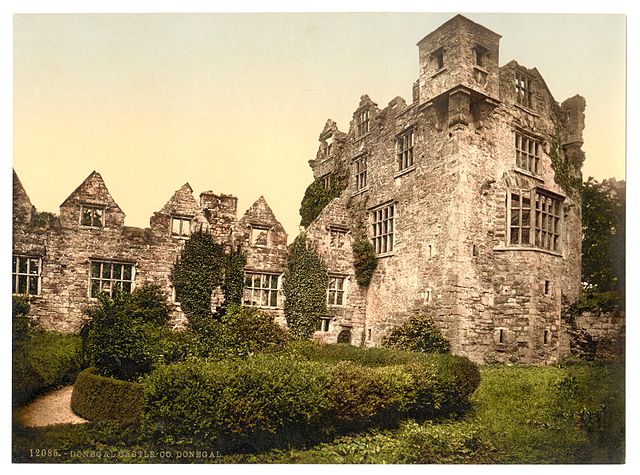Built by the O’Donnells, in 1474, Donegal Castle served as the seat of their formidable power until 1607.
Donegal Castle stands in the centre of Donegal Town in the northwest of Ireland. For most of the last two centuries, the majority of the buildings lay in ruins, but the castle was almost entirely restored in the late 1990s.
Stronghold of the O’Donnell Clan
The castle consists of a 15th-century rectangular keep with a later Jacobean style wing. The complex is sited on a bend in the River Eske, near the mouth of Donegal Bay, and is surrounded by a 17th-century boundary wall. There is a small gatehouse at its entrance mirroring the design of the keep. Most of the stonework consists of locally sourced limestone with some sandstone. The castle was the stronghold of the O’Donnell clan, Lords of Tír Conaill and one of the most powerful Gaelic families in Ireland from the 5th to the 16th centuries.
On Wednesday, 25 May 2016, the castle was visited by The Prince of Wales and The Duchess of Cornwall, during their official visit to County Donegal.
Fort of the Foreigner
It is sometimes referred to as the Fort of the Foreigner, possibly because of a Viking fortress in the area that was destroyed in 1159. However, due to hundreds of years of development, no archaeological evidence of this early fort has been found. The elder Sir Hugh O’Donnell, wealthy chief of the O’Donnell clan, built the castle in 1474. At the same time, he and his wife Nuala, built a Franciscan monastery further down the river. A local legend[citation needed] tells of a tunnel connecting the two, but no evidence for this has been found. The castle was regarded as one of the finest Gaelic castles in Ireland. This was indicated by a report by the visiting English Viceroy, the Lord Deputy of Ireland, Sir Henry Sidney, in 1566, in a letter to William Cecil, 1st Baron Burghley, the Lord High Treasurer, describing it as “the largest and strongest fortress in all Ireland”, adding:
“it is the greatest I ever saw in an Irishman’s hands: and would appear to be in good keeping; one of the fairest situated in good soil and so nigh a portable water a boat of ten tons could come within ten yards of it.”
Flight of the O’Donnells
In 1607, after the Nine Years War, the leaders of the O’Donnell clan left Ireland in the Flight of the Earls. In 1611 the castle and its lands were granted to an English Captain, Basil Brooke. The keep had been severely damaged by the departing O’Donnells to prevent the castle being used against the Gaelic clans but was quickly restored by its new owners. Brooke also added windows, a gable and a large manor-house wing to the keep, all in the Jacobean style. The Brooke family owned the castle for many generations until it fell into a ruinous state in the 18th century. In 1898 the then owner, the Earl of Arran, donated the castle to the Office of Public Works.
Donegal Castle – Entirely Restored
Recently the Office of Public Works has renovated the castle. The keep has had new roofing and flooring added, in keeping with the original styles and techniques used in the 15th and 17th centuries. The stonework has been restored and the manor wing has been partially roofed. The oak timbers used came from the Brookeborough Estate in County Fermanagh. The castle is now open to the public and often hosts events such as Gaelic cultural evenings.



